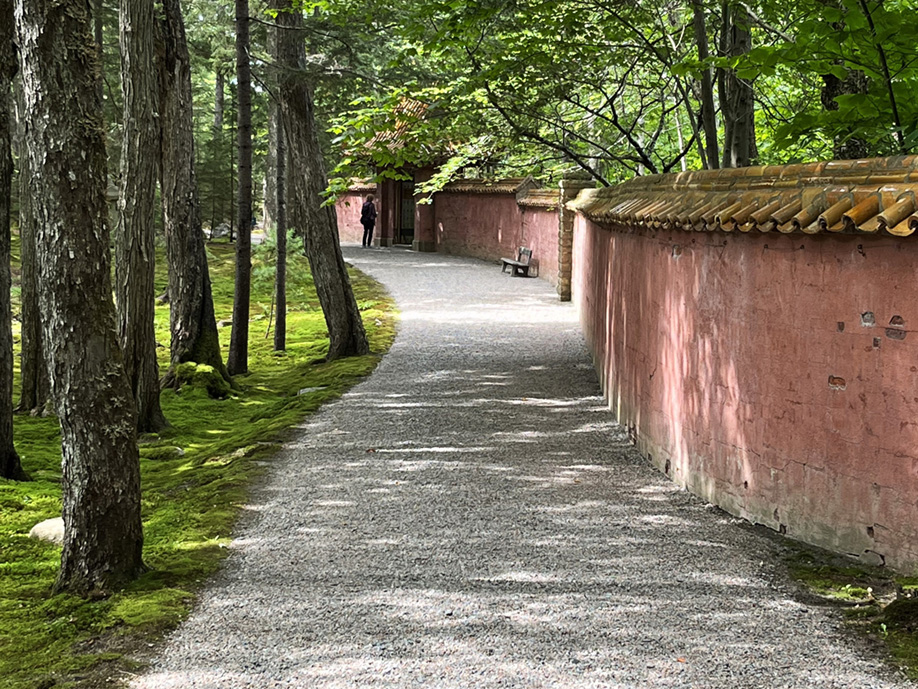
photo by Nadie VanZandt
Noted landscape architect Beatrix Farrand designed an English-style garden for the Rockefellers at their summer home on Mount Desert Island, Me., adding many stunning architectural features such as the undulating stone wall that surrounds the perennial gardens.
by Nadie VanZandt, Extension Master Gardener, University of Vermont
PANTON – A prominent figure in the history of American landscape design, Beatrix Farrand née Jones (1872-1959) was the mastermind behind the idyllic grounds of the Abby Aldrich Rockefeller Garden on Mount Desert Island in Maine and Dumbarton Oaks Gardens in Washington, D.C., among numerous others.
Farrand was born into a wealthy, well-connected family of the Gilded Age society of New York City. She was close to her paternal aunt, the famous novelist Edith Wharton, and grew up exposed to her mother’s elite social circle, which included Henry James, a wealthy American-British writer.
As a child, Farrand enjoyed gardening alongside her mother at Reef Point, the family’s summer home in Bar Harbor, Me. Her interest in gardening grew, and despite the lack of formal training in landscape architecture in the 1890s, she forged ahead on her own, enrolling in a drafting course with a private tutor at Columbia University’s School of Mines.

photo by Nadie VanZandt
A round window from inside a garden room looks out into the perennial beds in the walled garden at the Abby Aldrich Rockefeller Garden on Mount Desert Island, Me.
In 1893, she studied horticulture and garden design as an apprentice of Charles Sprague Sargent, then director of the Arnold Arboretum at Harvard University.
She undertook a grand tour of European gardens in 1895, further soaking up valuable information. There, she met with renowned landscape designers, including William Robinson and Gertrude Jekyll, leading advocates for wild gardening and cottage gardens. She returned home at the age of 23 emboldened and opened her own practice as a self-titled “landscape gardener,” which she ran from a room in her mother’s house in New York City.
By 1899, her practice was flourishing and her social connections with the elite led to commissions for major luxury estates such as that of the Rockefellers. Her style was described as elegant and restrained with rich architectural details.
That same year, at the age of 27, decades before women gained the right to vote, Farrand was the only woman among 11 professionals who founded the American Society of Landscape Architects.
At the turn of the 20th century, landscape architecture was a field long dominated by men, especially in the design of public places. Self-trained, yet equally competent, Farrand defied the odds and was hired as the first consulting landscape architect at Princeton University (1912-1943), hired to design the campus’s landscape. Other prestigious institutions, namely Yale, Harvard, Oberlin College and the University of Chicago, followed suit, hiring her to design their grounds.
If you visit the Ivy Leagues, look for Farrand’s legacy in the form of vine-covered wall gardens and native plants and trees that bloom in spring or fall when the university is in session. She favored sugar maples, sweet gums, beech and tulip poplars, seamlessly blending the elements of European formal gardens with the naturalistic beauty of the American landscape. Her goal was to offer an aesthetically pleasing environment for students to thrive.
In 1913, she met her husband, Max Farrand, at a dinner engagement with the Yale University president. A graduate of Princeton’s Class of 1892, he was then chairman of Yale’s history department.
The couple moved to California in 1927 when her husband was appointed director of the Huntington Library. There, Farrand expanded her client-base, taking on new design projects, such as the courtyard of Dabney Hall at the California Institute of Technology, parts of Occidental College and the Santa Barbara Botanical Garden, among others. Meanwhile, she commuted to the East coast to attend to her existing clients.
Recognized as America’s first female landscape architect, her prolific 50-year career led to more than 200 commissions. Her iconic and artful landscapes inspired future generations of women to pursue studies in the field of landscape architecture and design.
Her most famous design is reflected in the Dumbarton Oaks gardens where she transformed, and spent 30 perfecting, the grounds of a Georgian Revival mansion in Washington, D.C.
Some say that her most significant project was the preservation and beautification of the carriage roads in Acadia National Park, commissioned by John D. Rockefeller Jr. However, the extensive and exquisite Abby Aldrich Rockefeller Garden on Mount Desert Island, an English-style garden with an Asian-inspired landscape designed for the Rockefellers, could certainly rival that as her masterpiece.
Farrand drew inspiration from visiting numerous gardens. Gardeners can do the same by visiting University of Vermont Extension Master Gardener Program demonstration gardens throughout the state. See information at go.uvm.edu/emgprojects.
[Nadie VanZandt is a UVM Extension Master Gardener from Panton.]





